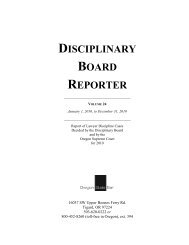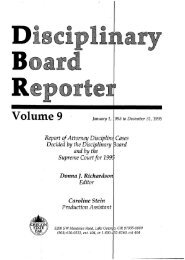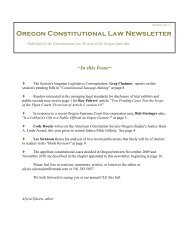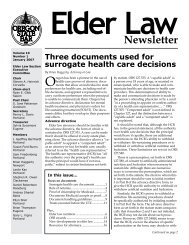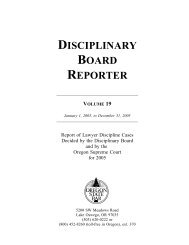Jackson v. Franklin Sports Gazette, Inc. Grading ... - Oregon State Bar
Jackson v. Franklin Sports Gazette, Inc. Grading ... - Oregon State Bar
Jackson v. Franklin Sports Gazette, Inc. Grading ... - Oregon State Bar
You also want an ePaper? Increase the reach of your titles
YUMPU automatically turns print PDFs into web optimized ePapers that Google loves.
Multistate Performance Test<br />
Model Answer<br />
<strong>Jackson</strong> v. <strong>Franklin</strong> <strong>Sports</strong> <strong>Gazette</strong>, <strong>Inc</strong>.<br />
reasonable to assume that the phrase “in connection with … sports broadcast or account” is<br />
broad enough to cover what the Miller court described as “incidental advertising of the news<br />
medium itself.” In addition, it can be assumed that the legislature was aware of the holding in<br />
Miller, and would have included statutory language to exclude ancillary uses of an individual’s<br />
image from the affirmative defense if it had intended the new statute to supersede Miller.<br />
<strong>Jackson</strong> may argue that the <strong>Gazette</strong>’s use of the Photo presents what the dissent in Miller<br />
referred to as an implied endorsement by <strong>Jackson</strong> of the <strong>Gazette</strong>. However, in Miller, the<br />
plaintiff was clearly identifiable in the photo, thus increasing the possibility that the viewing<br />
public could conclude that the plaintiff was endorsing the publication. But again, the majority<br />
rejected that view, concluding that the advertisement’s photo and text did not “tie [the plaintiff]<br />
explicitly to the solicitation for subscriptions.” Likewise, the text in the <strong>Gazette</strong>’s advertisement<br />
which directly refers to the Photo states, “Look at all you get: … award-winning photos like this<br />
that put you right in the middle of the action!!!” The Photo was expressly used to illustrate the<br />
quality of the <strong>Gazette</strong>’s news coverage. If the <strong>Gazette</strong> had wanted to ensure that the public<br />
connected its coverage with <strong>Jackson</strong>, the text could have mentioned “photos of Action <strong>Jackson</strong><br />
and all your favorite Blue Sox players” or otherwise singled him out for notice.<br />
Conclusion<br />
It appears likely that <strong>Jackson</strong>’s complaint against the <strong>Gazette</strong> does not state a cause of<br />
action under the right of publicity statute, <strong>Franklin</strong> Code § 62. To state a claim, <strong>Jackson</strong> must be<br />
readily identifiable in the Photo. While a member of the public could assume that it is <strong>Jackson</strong> in<br />
the Photo, as he may be the player who most readily comes to mind when the Blue Sox are<br />
mentioned, given the number of other Caucasian players who wear or have worn a team number<br />
ending in “0” in the past 25 years, it is unreasonable to conclude that the Photo is of <strong>Jackson</strong>, as<br />
opposed to one of those other players. The use in the advertisement of the word “action” as a<br />
common noun should not alter this result.<br />
Further, if a court were to find that the <strong>Gazette</strong> did use <strong>Jackson</strong>’s image to its benefit<br />
without consent, the facts at hand could come within the affirmative defense for news reporting.<br />
Assuming Miller remains good law, the <strong>Gazette</strong> may make incidental use of <strong>Jackson</strong>’s image in<br />
advertising the newspaper. Nor under Miller do the facts support the conclusion that the use of<br />
the Photo is an implicit endorsement by <strong>Jackson</strong> of the <strong>Gazette</strong>.<br />
21<br />
Not for Public Distribution







